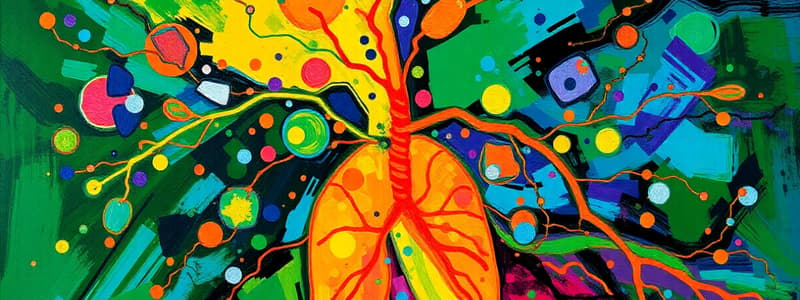Podcast
Questions and Answers
What is the primary source of energy for most living organisms?
What is the primary source of energy for most living organisms?
- Heat from the Earth's core
- Chemicals released by bacteria
- Sunlight (correct)
- The breakdown of rocks
Which of the following is NOT a role of producers in an ecosystem?
Which of the following is NOT a role of producers in an ecosystem?
- Providing food for consumers
- Breaking down organic matter into simpler compounds (correct)
- Releasing oxygen into the atmosphere
- Capturing energy from the sun
What is the primary difference between photosynthesis and cellular respiration?
What is the primary difference between photosynthesis and cellular respiration?
- Photosynthesis requires sunlight, while cellular respiration does not. (correct)
- Photosynthesis releases energy, while cellular respiration stores energy.
- Photosynthesis is used by all living organisms, while cellular respiration is only used by plants.
- Photosynthesis produces carbon dioxide, while cellular respiration produces oxygen.
What is the relationship between albedo and the amount of sunlight absorbed by a surface?
What is the relationship between albedo and the amount of sunlight absorbed by a surface?
Which of the following is an example of a primary consumer?
Which of the following is an example of a primary consumer?
How does the second law of thermodynamics apply to energy transfer in ecosystems?
How does the second law of thermodynamics apply to energy transfer in ecosystems?
Which process is used by organisms living near deep-sea vents to obtain energy, given the absence of sunlight?
Which process is used by organisms living near deep-sea vents to obtain energy, given the absence of sunlight?
What does the equation 6CO2 + 6H2O + light energy → C6H12O6 + 6O2 represent?
What does the equation 6CO2 + 6H2O + light energy → C6H12O6 + 6O2 represent?
Flashcards
Energy in Organisms
Energy in Organisms
Living things need energy for growth, movement, and survival.
Cellular Respiration
Cellular Respiration
Process that breaks down food (glucose) with oxygen to release energy.
Photosynthesis
Photosynthesis
Process by which plants use sunlight to make food (glucose) and oxygen.
Producers
Producers
Signup and view all the flashcards
Consumers
Consumers
Signup and view all the flashcards
Albedo
Albedo
Signup and view all the flashcards
Chemosynthesis
Chemosynthesis
Signup and view all the flashcards
First and Second Laws of Thermodynamics
First and Second Laws of Thermodynamics
Signup and view all the flashcards
Study Notes
Energy in Organisms
- All living things need energy for growth, movement, and survival
- Energy is released through cellular respiration (breaking down carbohydrates) or fermentation (without oxygen)
- Producers (plants) use photosynthesis to capture sunlight energy and create food (carbohydrates)
- Consumers (animals) obtain energy by consuming other organisms.
Photosynthesis and Cellular Respiration
- Photosynthesis: Plants capture sunlight, water, and carbon dioxide to produce glucose (food) and oxygen
- Equation: 6CO2 + 6H2O + light energy → C6H12O6 + 6O2
- Cellular Respiration: Organisms break down food (like glucose) with oxygen, releasing energy
- Equation: C6H12O6 + 6O2 → 6CO2 + 6H2O + energy
Producers and Consumers
- Producers (autotrophs): Make their own food using sunlight
- Consumers (heterotrophs): Obtain energy by eating producers or other consumers.
- Primary Consumers: Herbivores that eat producers (e.g., insects, deer).
- Secondary Consumers: Carnivores that eat primary consumers and/or producers (e.g., frogs, small birds).
- Tertiary Consumers: Apex predators that eat secondary consumers (e.g., hawks, lions).
Energy Transfer
- Most of the sun's energy is reflected or absorbed by the atmosphere
- Only 1-2% of the sun's energy is captured by producers to make food.
Albedo
- Albedo is a measure of how much sunlight is reflected by a surface
- Surfaces with high albedo (e.g., snow, ice) reflect more sunlight, while those with low albedo (e.g., oceans, forests) reflect less
Chemosynthesis
- Some organisms (e.g., bacteria near deep-sea vents) use chemosynthesis to obtain energy from chemicals instead of sunlight
- Chemosynthesis is similar to photosynthesis, but uses chemicals as the energy source.
First and Second Law of Thermodynamics
- First Law: Energy cannot be created or destroyed, only transformed
- Second Law: Energy transformations are never 100% efficient, some energy is lost as heat (making the process less useful over time)
Studying That Suits You
Use AI to generate personalized quizzes and flashcards to suit your learning preferences.



